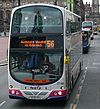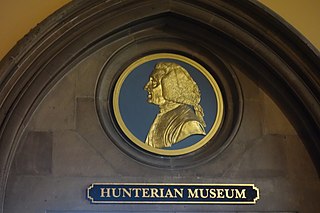
The University of Glasgow's museum dedicated to William Hunter is the oldest museum in Scotland. It covers the Hunterian Museum, the Hunterian Art Gallery, the Mackintosh House, the Zoology Museum and the Anatomy Museum, all located in various buildings on the main campus of the University in the west end of Glasgow.

Cathcart is an area of Glasgow between Battlefield, Mount Florida, King's Park, Muirend and Newlands. The White Cart Water flows through Cathcart, downstream from Linn Park. In 2014, it was rated one of the most attractive postcode areas to live in Scotland.
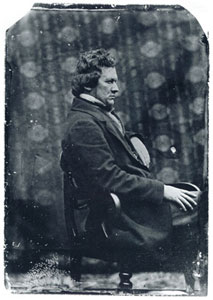
Alexander "Greek" Thomson was an eminent Scottish architect and architectural theorist who was a pioneer in sustainable building. Although his work was published in the architectural press of his day, it was little appreciated outside Glasgow during his lifetime. It has only been since the 1950s and 1960s that his critical reputation has revived—not least of all in connection with his probable influence on Frank Lloyd Wright.

Inchinnan is a small village in Renfrewshire, Scotland. The village is located on the main A8 road between Renfrew and Greenock, just south east of the town of Erskine.

Netherlee is a suburban residential area in East Renfrewshire, Scotland. It is situated on the west bank of the White Cart Water about 4 miles (6.5 km) south of Glasgow city centre. Part of the Greater Glasgow conurbation, it is mostly contiguous with the city, and is just beyond the boundary of its local authority area. It is a separate census locality from Glasgow, like other areas such as neighbouring Giffnock and Clarkston. Netherlee is directly contiguous with Stamperland. It is also in a council ward with Clarkston and its neighbour Busby. As of 2012, Netherlee has a population of 4,550.
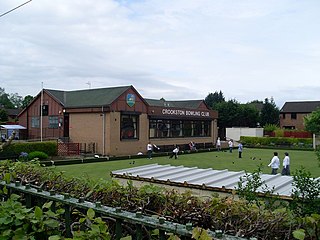
Crookston is a residential suburb on the southwestern edge of the city of Glasgow, Scotland.

Sauchiehall Street is one of the main shopping streets in the city centre of Glasgow, Scotland, along with Buchanan Street and Argyle Street.
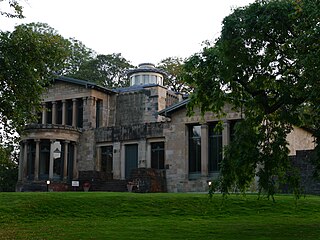
Holmwood House is the finest and most elaborate residential villa designed by the Scottish architect Alexander "Greek" Thomson. It is also rare in retaining much of its original interior decor, and being open to the public. A Category A listed building, the villa is located at 61-63 Netherlee Road, Cathcart, in the southern suburbs of Glasgow, and is owned by the National Trust for Scotland.

Walmer Crescent, situated in Cessnock, Glasgow, Scotland, consists of a curved row of spacious tenement flats and houses, designed by the architect Alexander Thomson and built between 1857 and 1862.

Cessnock is an area in the city of Glasgow, Scotland. It is situated south of the River Clyde and was part of the former Burgh of Govan. Cessnock's main street is Paisley Road West, which runs west in the direction of Paisley and east through Kinning Park to Paisley Toll.

The Centre for Contemporary Arts (CCA) is an arts centre in Glasgow, Scotland. The year-round programme includes exhibitions, film, music, literature, spoken word, festivals, Gaelic and performance. The Centre works with artists, commissions new projects and presents them to the widest possible audience.
22 Park Circus is a 19th-century townhouse in the West End of Glasgow, Scotland. Originally a family home, it was later a club and an Italian consulate. From 1994 to 2013 the building housed the city's register office.

The Memorial Gates at the University of Glasgow were erected in 1952 as a celebration of the University's quincentenary, or five hundredth anniversary. They form a portal through the University Avenue side of the perimeter fence around the University's current site on Gilmorehill. They stand before the Hunter memorial and Hunterian Museum, on the other side of the John McIntyre Building from the Main Gate. The large gates in the centre are generally locked, although the small pedestrian gates to the left and right are opened during the day. The gates bear the names of thirty distinguished figures associated with the University. The gates are protected as a category B listed building.

The West End of Edinburgh, Scotland, forms a large part of the city centre. The West End boasts several of the city's hotels, restaurants, independent shops, offices and arts venues, including the Edinburgh Filmhouse, Edinburgh International Conference Centre and the Caledonian Hotel. The area also hosts art festivals and crafts fairs.

The Egyptian Halls is a category A listed building at 84–100 Union Street, Glasgow, Scotland. It was built between 1870–72 and designed by Alexander "Greek" Thomson. Other than some retailers on the ground floor, the building is currently unoccupied. Despite several attempts at restoration, it remains in a parlous state and was under threat of demolition in 2011. Planning approval and listed building consent has since been given for a scheme which has secured funding for conversion to a 114-bed four-star hotel. As of 20 February 2013, subsidy was still being sought for work to the ground floor.
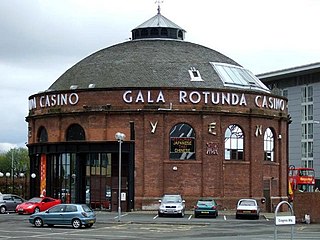
The Glasgow Harbour Tunnel Rotundas are two red brick stone buildings which flank the River Clyde. The North Rotunda is located on Tunnel Street in the Finnieston area of Glasgow with the South Rotunda at Plantation Place in Govan.
Cardonald Place Farm is a farmhouse on the banks of the White Cart Water river in Cardonald, Glasgow, Scotland. It was built in 1848 on the site occupied by the former Cardonald Palace.

Cathcart Cemetery is a cemetery in East Renfrewshire, Scotland, which was opened in 1878. It is named after the nearby neighbourhood of Cathcart on the southern outskirts of Glasgow, but does not actually fall within the city boundaries. It is bounded to the east by the White Cart Water, with Linn Park on the opposite bank. Other surrounding residential areas to the west are Muirend and Netherlee. The grounds of Holmwood House, a mansion designed by Alexander 'Greek' Thomson, are located a short distance to the north.

Royal Terrace is a grand street in the city of Edinburgh, Scotland, on the north side of Calton Hill within the New Town and part of the UNESCO World Heritage Site inscribed in 1995, built on the south side of a setted street, facing the sloping banks of London Road Gardens, formerly Royal Terrace Gardens, with views looking north towards Leith and the Firth of Forth.

Carlton Terrace is a residential street in Edinburgh, Scotland. It is located on the east side of Calton Hill, at the eastern extremity of the New Town, part of the UNESCO World Heritage Site inscribed in 1995.




















